...
“”"
from bs4 import BeautifulSoup
soup = BeautifulSoup(html, ‘lxml’)
print(soup.p.contents)
['\n Once upon a time there were three little sisters; and their names were\n ',
Elsie
, ‘\n’, Lacie, ’ \n and\n ', Tillie, '\n and they lived at the bottom of a well.\n ']
html = “”"
Once upon a time there were three little sisters; and their names were
Elsie
and
and they lived at the bottom of a well.
...
“”"
from bs4 import BeautifulSoup
soup = BeautifulSoup(html, ‘lxml’)
print(soup.p.children)
for i, child in enumerate(soup.p.children):
print(i, child)
<list_iterator object at 0x1064f7dd8>
0
Once upon a time there were three little sisters; and their names were
Elsie
2
3 Lacie
4
and
5 Tillie
6
and they lived at the bottom of a well.
html = “”"
Once upon a time there were three little sisters; and their names were
Elsie
and
and they lived at the bottom of a well.
...
“”"
from bs4 import BeautifulSoup
soup = BeautifulSoup(html, ‘lxml’)
print(soup.p.descendants)
for i, child in enumerate(soup.p.descendants):
print(i, child)
<generator object descendants at 0x10650e678>
0
Once upon a time there were three little sisters; and their names were
Elsie
2
3 Elsie
4 Elsie
5
6
7 Lacie
8 Lacie
9
and
10 Tillie
11 Tillie
12
and they lived at the bottom of a well.
3.7父节点和祖先节点
html = “”"
Once upon a time there were three little sisters; and their names were
Elsie
and
and they lived at the bottom of a well.
...
“”"
from bs4 import BeautifulSoup
soup = BeautifulSoup(html, ‘lxml’)
print(soup.a.parent)
Once upon a time there were three little sisters; and their names were
Elsie
and
and they lived at the bottom of a well.
html = “”"
Once upon a time there were three little sisters; and their names were
Elsie
and
and they lived at the bottom of a well.
...
“”"
from bs4 import BeautifulSoup
soup = BeautifulSoup(html, ‘lxml’)
print(list(enumerate(soup.a.parents)))
[(0,
Once upon a time there were three little sisters; and their names were
Elsie
and
and they lived at the bottom of a well.
), (1,
Once upon a time there were three little sisters; and their names were
Elsie
and
and they lived at the bottom of a well.
...
), (2,
Once upon a time there were three little sisters; and their names were
Elsie
and
and they lived at the bottom of a well.
...
), (3,
Once upon a time there were three little sisters; and their names were
Elsie
and
and they lived at the bottom of a well.
...
)]3.8兄弟节点
html = “”"
Once upon a time there were three little sisters; and their names were
Elsie
and
and they lived at the bottom of a well.
...
“”"
from bs4 import BeautifulSoup
soup = BeautifulSoup(html, ‘lxml’)
print(list(enumerate(soup.a.next_siblings)))
print(list(enumerate(soup.a.previous_siblings)))
[(0, ‘\n’), (1, Lacie), (2, ’ \n and\n '), (3, Tillie), (4, '\n and they lived at the bottom of a well.\n ')]
[(0, '\n Once upon a time there were three little sisters; and their names were\n ')]
4.1find_all( name , attrs , recursive , text , **kwargs )
可根据标签名、属性、内容查找文档
4.1.1name
html=‘’’
Hello
- Foo
- Bar
- Jay
- Foo
- Bar
‘’’
from bs4 import BeautifulSoup
soup = BeautifulSoup(html, ‘lxml’)
print(soup.find_all(‘ul’))
print(type(soup.find_all(‘ul’)[0]))
[
- Foo
- Bar
- Jay
- ,
- Foo
- Bar
- ]
<class ‘bs4.element.Tag’>
html=‘’’
Hello
- Foo
- Bar
- Jay
- Foo
- Bar
‘’’
from bs4 import BeautifulSoup
soup = BeautifulSoup(html, ‘lxml’)
for ul in soup.find_all(‘ul’):
print(ul.find_all(‘li’))
[
- Foo
- ,
- Bar
- ,
- Jay
- ]
[
- Foo
- ,
- Bar
- ]
4.1.2attrs
html=‘’’
Hello
- Foo
- Bar
- Jay
- Foo
- Bar
‘’’
from bs4 import BeautifulSoup
soup = BeautifulSoup(html, ‘lxml’)
print(soup.find_all(attrs={‘id’: ‘list-1’}))
print(soup.find_all(attrs={‘name’: ‘elements’}))
[
- Foo
- Bar
- Jay
- ]
[
- Foo
- Bar
- Jay
- ]
html=‘’’
Hello
- Foo
- Bar
- Jay
- Foo
- Bar
‘’’
from bs4 import BeautifulSoup
soup = BeautifulSoup(html, ‘lxml’)
print(soup.find_all(id=‘list-1’))
print(soup.find_all(class_=‘element’))
[
- Foo
- Bar
- Jay
- ]
[
- Foo
- ,
- Bar
- ,
- Jay
- ,
- Foo
- ,
- Bar
- ]
4.1.3text
html=‘’’
Hello
- Foo
- Bar
- Jay
- Foo
- Bar
‘’’
from bs4 import BeautifulSoup
soup = BeautifulSoup(html, ‘lxml’)
print(soup.find_all(text=‘Foo’))
[‘Foo’, ‘Foo’]
4.2find( name , attrs , recursive , text , **kwargs )
find返回单个元素,find_all返回所有元素
html=‘’’
Hello
- Foo
- Bar
- Jay
- Foo
- Bar
‘’’
from bs4 import BeautifulSoup
soup = BeautifulSoup(html, ‘lxml’)
print(soup.find(‘ul’))
print(type(soup.find(‘ul’)))
print(soup.find(‘page’))
- Foo
- Bar
- Jay
<class ‘bs4.element.Tag’>
None
4.3find_parents() find_parent()
find_parents()返回所有祖先节点,find_parent()返回直接父节点。
4.4find_next_siblings() find_next_sibling()
find_next_siblings()返回后面所有兄弟节点,find_next_sibling()返回后面第一个兄弟节点。
4.5find_previous_siblings() find_previous_sibling()
find_previous_siblings()返回前面所有兄弟节点,find_previous_sibling()返回前面第一个兄弟节点。
4.6find_all_next() find_next()
find_all_next()返回节点后所有符合条件的节点, find_next()返回第一个符合条件的节点
4.7find_all_previous() 和 find_previous()
find_all_previous()返回节点后所有符合条件的节点, find_previous()返回第一个符合条件的节点
通过select()直接传入CSS选择器即可完成选择
html=‘’’
Hello
- Foo
- Bar
- Jay
- Foo
- Bar
‘’’
from bs4 import BeautifulSoup
soup = BeautifulSoup(html, ‘lxml’)
print(soup.select(‘.panel .panel-heading’))
print(soup.select(‘ul li’))
print(soup.select(‘#list-2 .element’))
print(type(soup.select(‘ul’)[0]))
[
Hello
][
- Foo
- ,
- Bar
- ,
- Jay
- ,
- Foo
- ,
- Bar
- ]
[
- Foo
- ,
- Bar
- ]
<class ‘bs4.element.Tag’>
html=‘’’
自我介绍一下,小编13年上海交大毕业,曾经在小公司待过,也去过华为、OPPO等大厂,18年进入阿里一直到现在。
深知大多数Python工程师,想要提升技能,往往是自己摸索成长或者是报班学习,但对于培训机构动则几千的学费,着实压力不小。自己不成体系的自学效果低效又漫长,而且极易碰到天花板技术停滞不前!
因此收集整理了一份《2024年Python开发全套学习资料》,初衷也很简单,就是希望能够帮助到想自学提升又不知道该从何学起的朋友,同时减轻大家的负担。
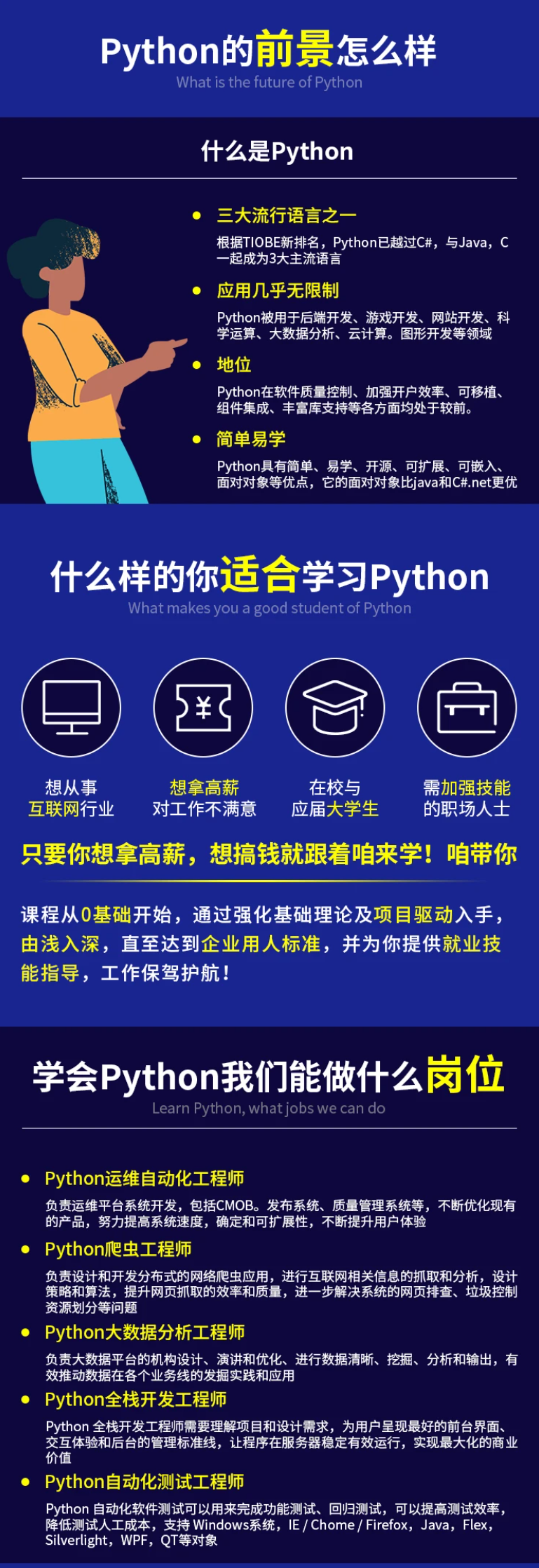
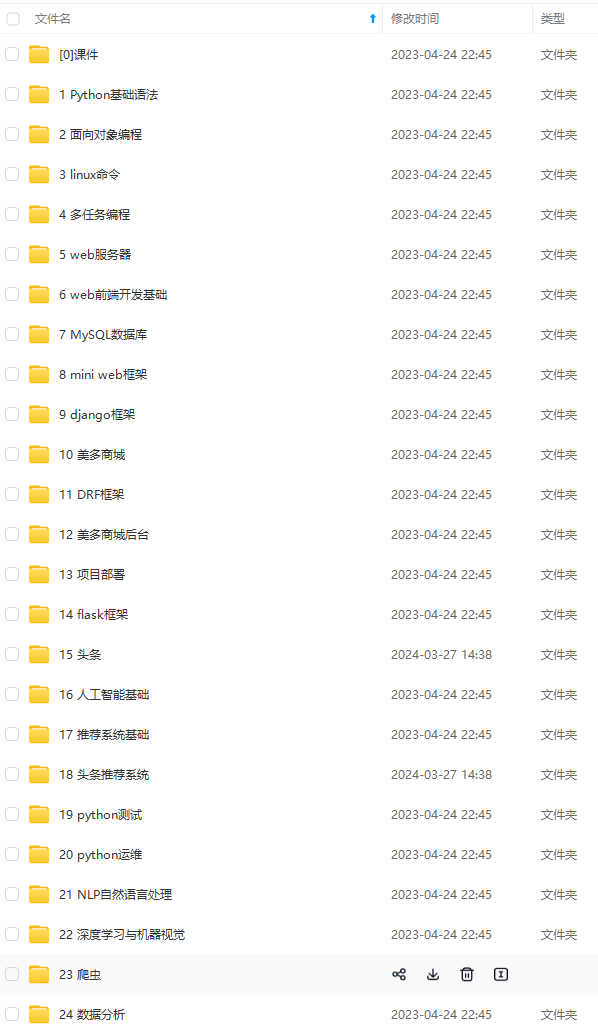
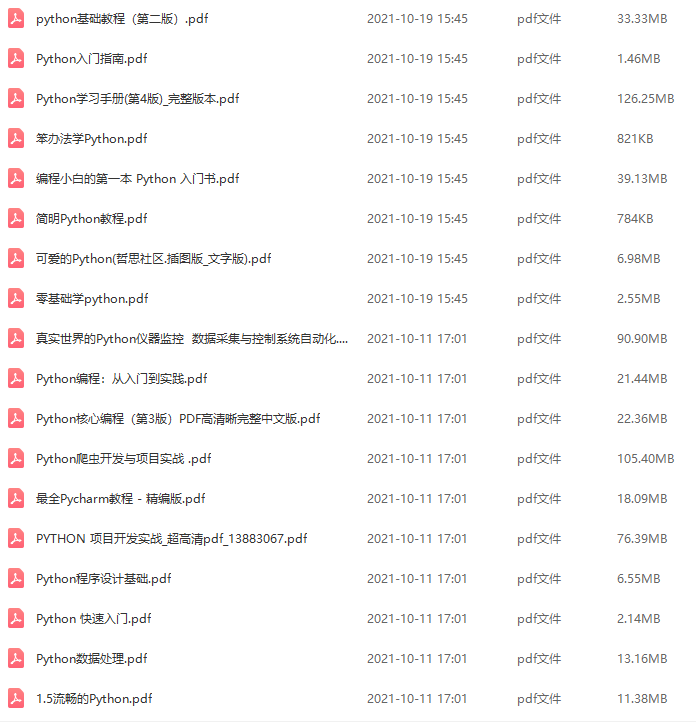
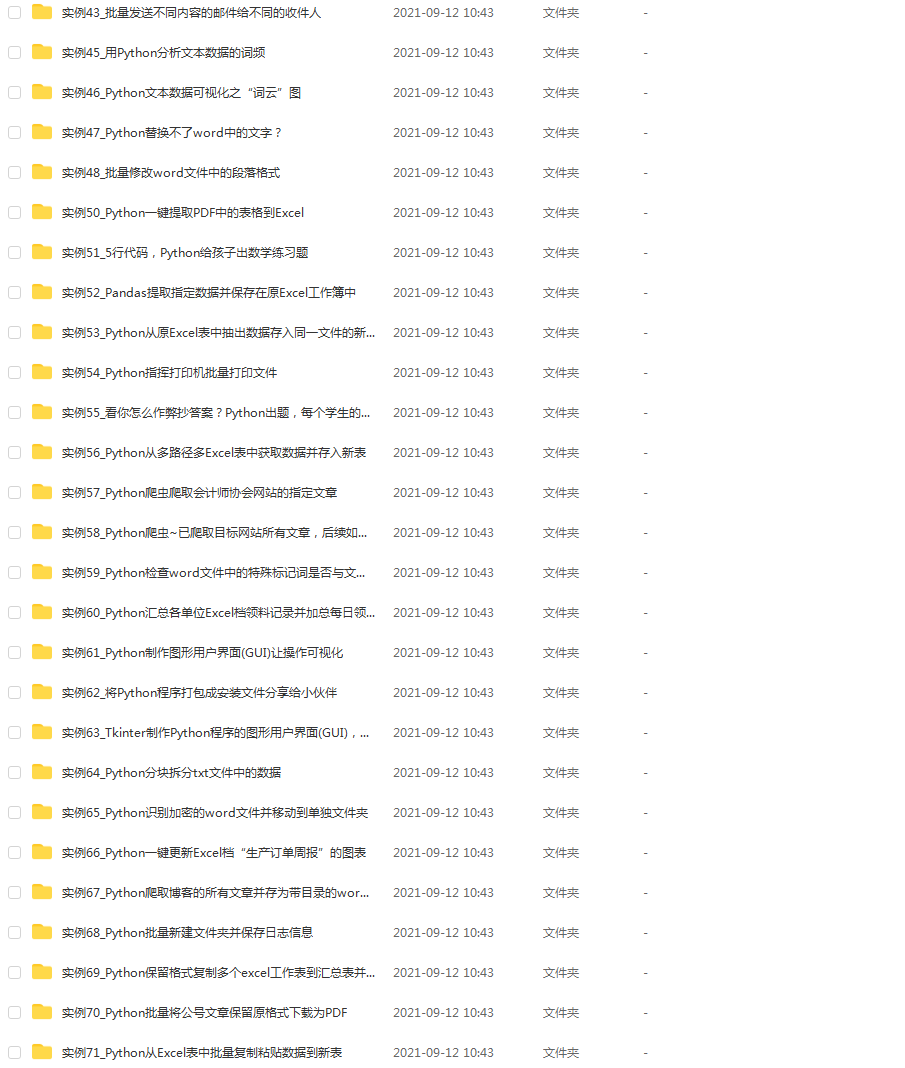
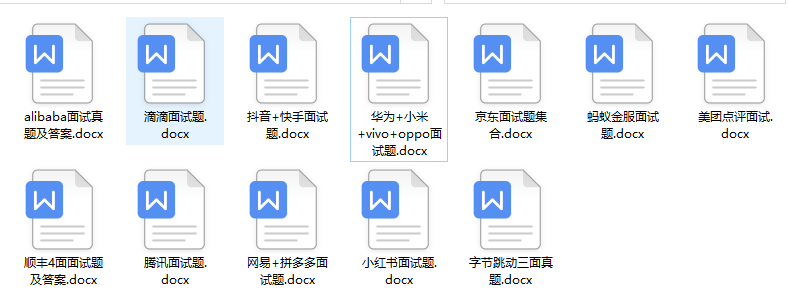

既有适合小白学习的零基础资料,也有适合3年以上经验的小伙伴深入学习提升的进阶课程,基本涵盖了95%以上Python开发知识点,真正体系化!
由于文件比较大,这里只是将部分目录大纲截图出来,每个节点里面都包含大厂面经、学习笔记、源码讲义、实战项目、讲解视频,并且后续会持续更新
如果你觉得这些内容对你有帮助,可以添加V获取:vip1024c (备注Python)

做了那么多年开发,自学了很多门编程语言,我很明白学习资源对于学一门新语言的重要性,这些年也收藏了不少的Python干货,对我来说这些东西确实已经用不到了,但对于准备自学Python的人来说,或许它就是一个宝藏,可以给你省去很多的时间和精力。
别在网上瞎学了,我最近也做了一些资源的更新,只要你是我的粉丝,这期福利你都可拿走。
我先来介绍一下这些东西怎么用,文末抱走。
(1)Python所有方向的学习路线(新版)
这是我花了几天的时间去把Python所有方向的技术点做的整理,形成各个领域的知识点汇总,它的用处就在于,你可以按照上面的知识点去找对应的学习资源,保证自己学得较为全面。
最近我才对这些路线做了一下新的更新,知识体系更全面了。
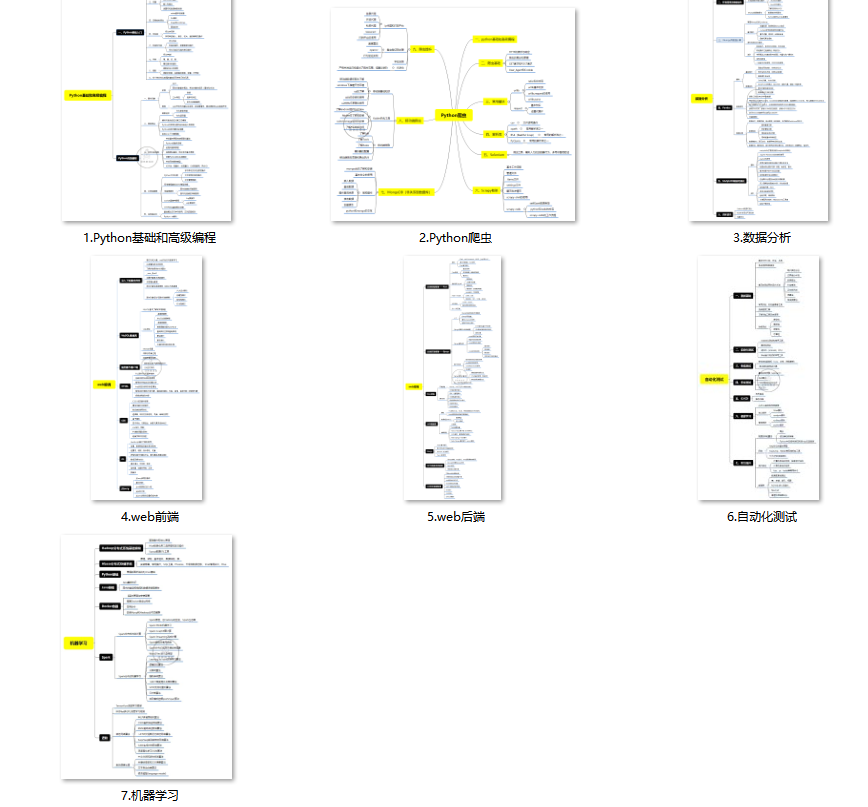
(2)Python学习视频
包含了Python入门、爬虫、数据分析和web开发的学习视频,总共100多个,虽然没有那么全面,但是对于入门来说是没问题的,学完这些之后,你可以按照我上面的学习路线去网上找其他的知识资源进行进阶。
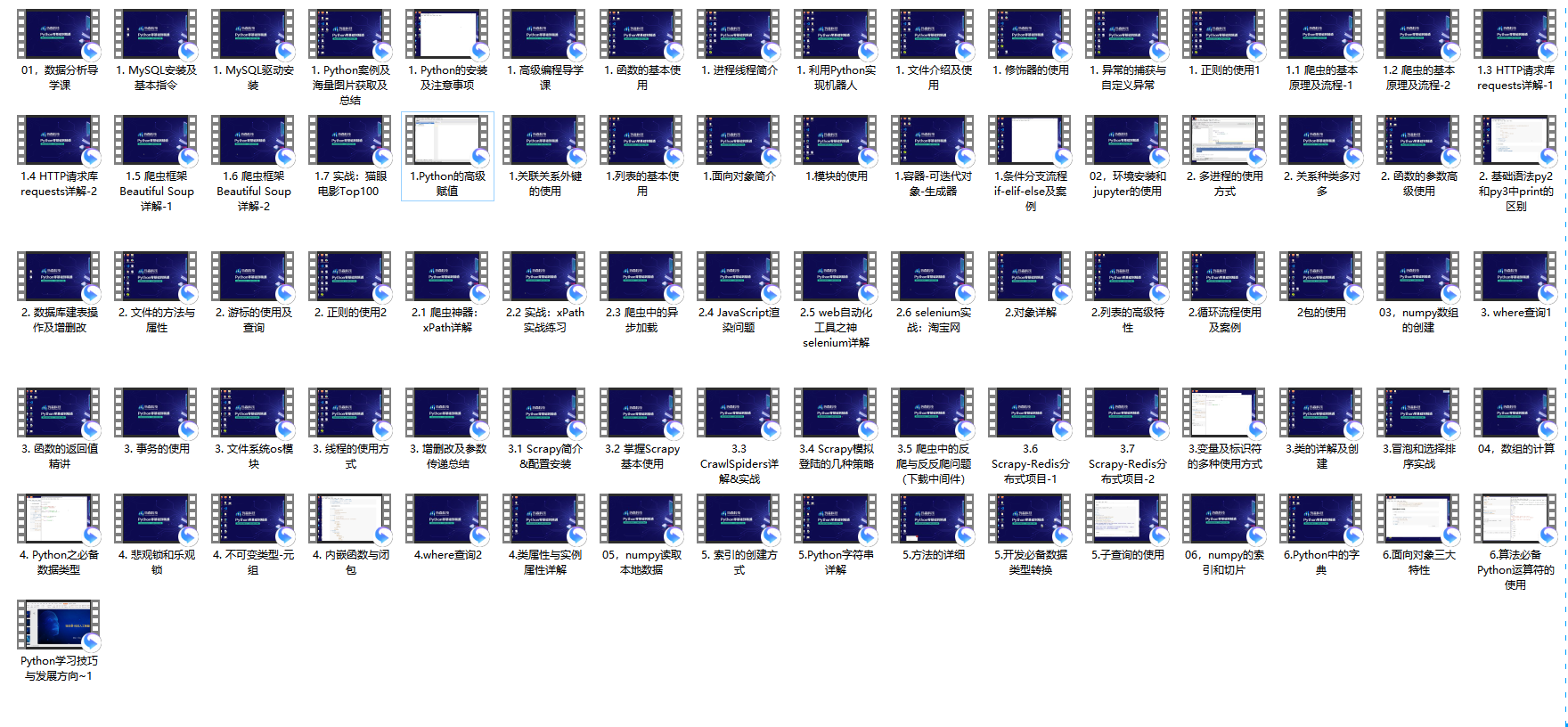
(3)100多个练手项目
我们在看视频学习的时候,不能光动眼动脑不动手,比较科学的学习方法是在理解之后运用它们,这时候练手项目就很适合了,只是里面的项目比较多,水平也是参差不齐,大家可以挑自己能做的项目去练练。
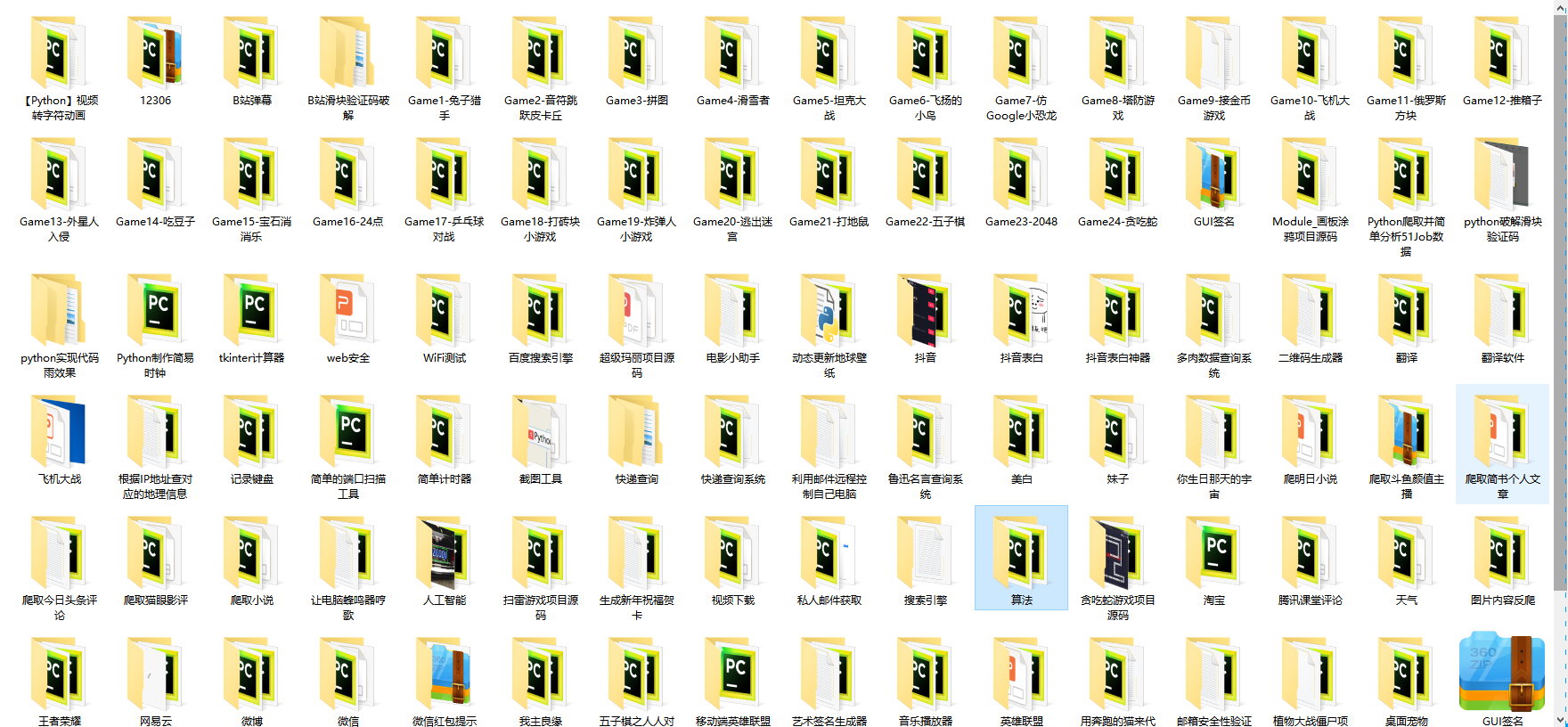
(4)200多本电子书
这些年我也收藏了很多电子书,大概200多本,有时候带实体书不方便的话,我就会去打开电子书看看,书籍可不一定比视频教程差,尤其是权威的技术书籍。
基本上主流的和经典的都有,这里我就不放图了,版权问题,个人看看是没有问题的。
(5)Python知识点汇总
知识点汇总有点像学习路线,但与学习路线不同的点就在于,知识点汇总更为细致,里面包含了对具体知识点的简单说明,而我们的学习路线则更为抽象和简单,只是为了方便大家只是某个领域你应该学习哪些技术栈。
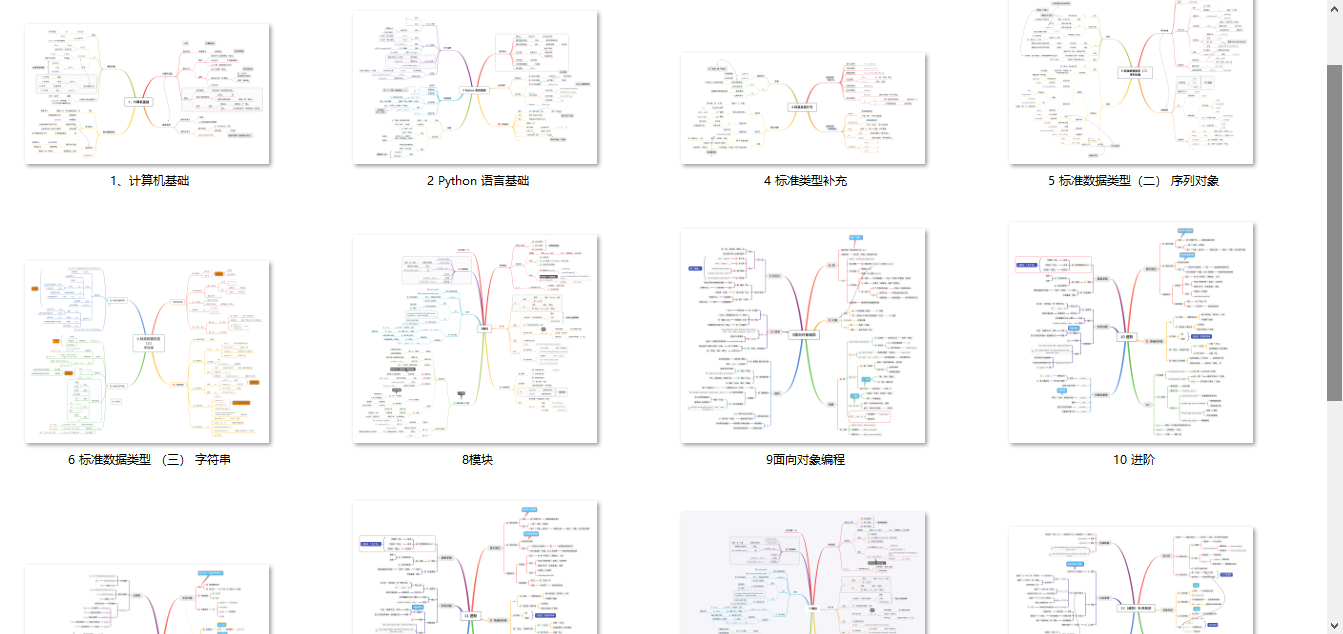
(6)其他资料
还有其他的一些东西,比如说我自己出的Python入门图文类教程,没有电脑的时候用手机也可以学习知识,学会了理论之后再去敲代码实践验证,还有Python中文版的库资料、MySQL和HTML标签大全等等,这些都是可以送给粉丝们的东西。

这些都不是什么非常值钱的东西,但对于没有资源或者资源不是很好的学习者来说确实很不错,你要是用得到的话都可以直接抱走,关注过我的人都知道,这些都是可以拿到的。
。

(2)Python学习视频
包含了Python入门、爬虫、数据分析和web开发的学习视频,总共100多个,虽然没有那么全面,但是对于入门来说是没问题的,学完这些之后,你可以按照我上面的学习路线去网上找其他的知识资源进行进阶。

(3)100多个练手项目
我们在看视频学习的时候,不能光动眼动脑不动手,比较科学的学习方法是在理解之后运用它们,这时候练手项目就很适合了,只是里面的项目比较多,水平也是参差不齐,大家可以挑自己能做的项目去练练。

(4)200多本电子书
这些年我也收藏了很多电子书,大概200多本,有时候带实体书不方便的话,我就会去打开电子书看看,书籍可不一定比视频教程差,尤其是权威的技术书籍。
基本上主流的和经典的都有,这里我就不放图了,版权问题,个人看看是没有问题的。
(5)Python知识点汇总
知识点汇总有点像学习路线,但与学习路线不同的点就在于,知识点汇总更为细致,里面包含了对具体知识点的简单说明,而我们的学习路线则更为抽象和简单,只是为了方便大家只是某个领域你应该学习哪些技术栈。

(6)其他资料
还有其他的一些东西,比如说我自己出的Python入门图文类教程,没有电脑的时候用手机也可以学习知识,学会了理论之后再去敲代码实践验证,还有Python中文版的库资料、MySQL和HTML标签大全等等,这些都是可以送给粉丝们的东西。

这些都不是什么非常值钱的东西,但对于没有资源或者资源不是很好的学习者来说确实很不错,你要是用得到的话都可以直接抱走,关注过我的人都知道,这些都是可以拿到的。





















 51万+
51万+











 被折叠的 条评论
为什么被折叠?
被折叠的 条评论
为什么被折叠?








